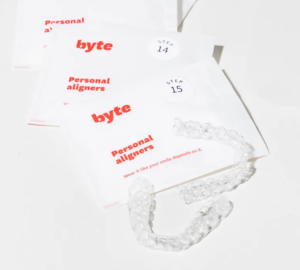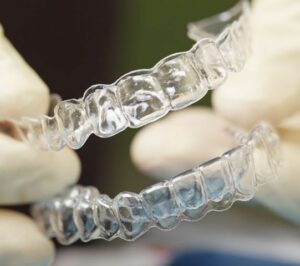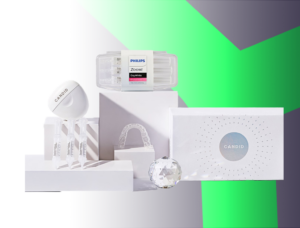
The desire for perfect-looking teeth is incredibly common, making orthodontic tools like Veneers or Invisalign aligners one of the most sought-after cosmetic enhancements.
Both dental veneers and Invisalign offer distinct advantages and cater to different needs. Veneers promise a dazzling, Hollywood-like smile with custom-made shells that permanently alter your teeth’s appearance. Invisalign, on the other hand, leverages clear aligners for a gradual, virtually invisible transformation.
This article delves into a comprehensive comparison between veneers or Invisalign treatment, empowering you to make an informed decision for your dental needs. Let’s unveil the secrets behind each approach, guiding you towards the perfect fit for your aesthetic goals and lifestyle!
What are Veneers?
Veneers are wafer-thin, custom-made shells bonded to the front surfaces of your teeth to enhance their appearance. These shells are crafted from durable materials, typically mimicking the natural look and translucency of real teeth.
The journey to your ideal veneer smile begins with consultations and impressions taken by your dentist. Based on your desired outcome, they meticulously design each veneer to complement your unique tooth shape, size, and color.
While primarily used for cosmetic purposes, veneers offer more than just a dazzling smile. They can conceal chips, dental cracks, and gaps and reshape teeth if needed. Veneers mask stubborn dental stains and also serve as a protection for weak teeth.
Different Veneers Material Choices:
- Porcelain Veneers: Renowned for their exceptional durability, stain resistance, and natural-looking translucency.
- Composite resin veneers: More affordable option, though less durable than porcelain and may require touch-ups over time.
- Dental Lumineers: Ultra-thin porcelain veneers requiring minimal tooth coating removal, often preferred for minimal cosmetic corrections.
- Removable Veneers: Often prefabricated or custom-fitted, but lack the durability and natural look of bonded options.
What Issues Do Veneers Solve?
- Chipped or cracked teeth: Restore their original shape and function.
- Unevenly spaced teeth: Close minor gaps for a seamless smile line.
- Severely stained teeth: Even tetracycline stains can be disguised effectively.
- Misshapen or worn teeth: Create a more symmetrical and aesthetically pleasing appearance.
Pros and Cons
While consulting a dentist is crucial to discuss your specific needs and determine if veneers are the right choice for you, weighing their pros and cons helps you make an informed decision.
Pros:
- Veneers improve the appearance of chipped, cracked, discolored, or misaligned teeth for a bright, confident smile.
- Porcelain veneers offer exceptional strength and stain resistance.
- Tailored design ensures each veneer seamlessly matches your natural tooth shape, size, and color for a natural-looking result.
- Can address minor structural issues like gaps or worn teeth, offering both dental aesthetic and functional benefits.
Cons:
- Requires removing a thin layer of dental coating, making the procedure irreversible.
- Veneers can be costly, depending on the material and number of teeth treated.
Remember, consulting a dentist is crucial to discuss your specific needs and determine if veneers are the right choice for you.
What are Clear Aligners (Invisalign)?
Invisalign is a world-known brand of clear aligners, a type of orthodontic treatment that uses transparent plastic trays to shift teeth into the desired position gradually. As Invisalign is a pioneering brand in clear aligner technology, its name is often used interchangeably with the term “clear aligners.” The brand is renowned for its quality and effectiveness in dental health niche.
More dentists and orthodontists choose Invisalign treatment over surgery, or braces and aligners of other types. This makes Invisalign a widely trusted option.
Invisalign aligners are custom-made for each patient based on 3D scans of their teeth and are worn over the teeth for typically 20-22 hours a day. They resemble thin, clear plastic trays that cover the teeth and are barely noticeable when worn. The aligners feel comfortable due to being thin, flexible, and lightweight.
How Invisalign Aligners are Made?
Invisalign aligners are crafted using advanced technology and a patented material called Invisalign SmartTrack®. The process begins with a 3D scan of the patient’s teeth taken at the orthodontist’s office, which is then used to create a custom treatment plan using specialized software. The aligners are fabricated using advanced manufacturing techniques, ensuring precision and quality.
Invisalign Aligners Product Lineup:
- Invisalign Lite: For patients with mild to moderate issues, lasts 6-7 months.
- Invisalign Teen: Designed for young adult patients, with the design including indicator dots.
- Invisalign i7: For patients with overcrowding, 3-6 months treatment time.
- Invisalign Full: For patients with advanced cases, 12-18 months duration.
Remember, choosing between Invisalign treatment and other clear aligners requires careful consideration of your individual requirements and preferences. While Invisalign is a leading dental aligner brand, various other clear aligner options exist, each with its own features and benefits.
Invisalign Aligners Advantages
- Utilizing 3D imaging, Invisalign crafts custom treatment plans for precise tooth movement, yielding predictable outcomes.
- Invisalign addresses various dental issues, from fixing tooth gap, mild to moderate dental misalignment, and bite problems, with specialized options for different age groups.
- Virtually invisible, making them less noticeable than metal braces.
- Removable, easier to maintain oral hygiene and enjoy dietary freedom.
- More comfortable than metal braces, with no brackets or wires to irritate your mouth.
Invisalign Drawbacks
- Clear aligners, including Invisalign, might not be suitable for every case, especially complex dental misalignment or severe bite problems.
When To Choose Invisalign Over Dental Veneers?
Before opting for Invisalign treatment over dental veneers, consider its benefits. Invisalign offers a discreet, removable alternative for cosmetic dentistry, ideal for mild to moderate misalignments. It requires a commitment to wearing aligners for 20-22 hours daily and regular dental visits for adjustments. Let’s weigh Invisalign in the most important aspects.
Price
Invisalign’s cost varies based on treatment complexity and duration, with the average cost ranging from $3000 to $8000. Generally, it’s pricier than traditional braces but may be comparable to veneers. If you want cost-effective alternatives, Byte costs begin from $1999 for its dental aligner treatment.
Treatment duration
Invisalign aligner treatment duration ranges from several months to over a year, depending on the complexity of the case. Aligner treatment duration typically spans 6-18 months, with some other reputable clear aligner brands such as Byte offering a shorter timeframe compared to Invisalign treatment for some patients.
Durability
Invisalign aligners, crafted from patented SmartTrack® material, offer durability throughout treatment. This advanced material ensures flexibility and resilience, capable of withstanding the rigors of daily wear. Despite their thin and lightweight design, Invisalign aligners maintain their structural integrity, providing reliable orthodontic correction.
Conditions
Invisalign effectively treats various orthodontic conditions, including overcrowding, gaps between teeth, and dental misalignment. They are considered highly effective aligners for overbite correction, where the upper teeth protrude beyond the lower teeth. With customized Invisalign aligners, patients experience comprehensive orthodontic correction for a wide range of dental concerns.
Esthetic appeal
Invisalign’s clear aligners offer discreet orthodontic treatment, virtually invisible when worn. Patients can enjoy a confident smile without the noticeable appearance of traditional braces, enhancing self-esteem during treatment.
Comfort
Invisalign aligners are made from a smooth, comfortable material, minimizing irritation to the gums and cheeks. Their custom-fit design ensures a snug yet gentle fit, allowing for comfortable wear throughout the day and night.
Maintenance and risks
Maintaining Invisalign aligners is simple with regular cleaning using a soft brush and lukewarm water. Occasionaly soaking them in vinegar and water solution, and keeping them in the aligner case when not are additional maintenance steps ensuring durability and cleanliness of your aligners.
Failure to wear aligners as directed can prolong treatment or lead to less effective results. Additionally, while rare, some patients may experience temporary discomfort or mild side effects during treatment.
When To Choose Dental Veneers over Invisalign Treatment?
Before considering veneers for cosmetic dentistry, understand their benefits. Veneers offer a quick solution for enhancing smile aesthetics, masking dental imperfections like stains and chips. Unlike Invisalign, they provide immediate results. However, they are irreversible and require ongoing maintenance.
You can consider Invisalign alternatives if seeking non-invasive and affordable options. Explore these aspects of dental veneers to make an informed choice.
Price
Veneer costs fluctuate based on material, teeth count, and case intricacy. On average, they range from $500 to $2,500 per tooth, with porcelain material being priciest. Conversely, composite veneers, at $250 to $1,500 per tooth, offer a more economical option.
Treatment duration
Veneers can typically be applied in just a few dental visits, providing a quicker solution in comparison to Invisalign, which may require several months to over a year for completion.
Durability
Veneers are durable and can last for many years with proper care, providing long-lasting smile enhancements. Porcelain veneers are the most durable, lasting 10-20 years with proper care. Invisalign aligners require replacement and may need touch-ups after treatment.
Conditions treated
Veneers primarily address cosmetic concerns such as stains, chips, and gaps, rather than orthodontic issues like misalignments, which are better suited for Invisalign.
Esthetic appeal
Veneers are a wonderful option when it comes to natural-looking results, seamlessly blending with surrounding teeth to create a beautiful, harmonious smile. While Invisalign focuses on straightening teeth with clear, invisible trays for a natural look. Both veneers or Invisalign offer similar esthetic appeal, and are hence popular treatment options when it comes to cosmetic dentistry.
Comfort
Veneers are custom-made to fit comfortably over the teeth, providing a smooth and natural feel. Veneers require minimal adjustment once placed, while Invisalign may cause initial discomfort as teeth shift.
Maintenance and risks
Veneers require good oral hygiene and can chip; minor enamel removal is necessary. Invisalign requires diligent wear and cleaning, with potential minor gum irritation.
There is a risk of veneers becoming loose or dislodged, requiring prompt attention from a dentist. Regular dental check-ups are essential to ensure the longevity of veneers and overall oral health.
Ultimately, the “better” choice between Veneers or Invisalign depends on your specific dental needs and personal priorities.



Invisalign vs Veneers: Patient Experience
Invisalign Experience
A systematic review points to improved Invisalign treatment efficacy, elevated further after the introduction of SmartForce and SmartTrack materials.
My journey with Invisalign started smoothly with a comfortable consultation and digital 3D scans. While I experience some pressure and some pain with new trays, particularly on my front teeth, it’s manageable and requires no medication. Now halfway through (tray 13/20), I’m amazed by the visible progress and excited to see the final results!
Beyond my experience, it’s crucial to remember that individual experiences with both Invisalign and veneers can vary greatly. A user on Trustpilot shares how his smile is straighter and healthier than ever! The aligner changes were easy, and the discomfort was minimal. Another one from Reddit praises the discreetness of Invisalign.
A reviewer on Better Business Bureau exclaims that Invisalign treatment took longer than expected, and she experienced some unexpected tooth sensitivity.
Veneers Experience
Veneers user experiences are also mixed, with a Trustpilot user sharing how the cosmetic dentistry solution was permanent, that boosted their confidence. A Reddit user says: “The transformation is incredible! Veneers are worth the investment for a picture-perfect smile.”
Some user experiences point towards the procedure being expensive, with worries of potential long-term effects.
A 2018 survey highlights veneers’ porcelain’s excellent aesthetics and durability, while composite offers a less durable, more conservative option.
While both options can enhance your smile, the ideal choice depends on your unique dental needs and personal priorities.
Invisalign or Veneers: Comparison Table
| Feature | Veneers | Invisalign |
| What it is | Thin shells bonded to teeth | Clear plastic trays that gradually shift teeth |
| Primary purpose | Improve aesthetics | Straighten teeth, address minor bite issues |
| Material | Porcelain, composite resin | SmartTrack® plastic |
| Treatment duration | Few appointments | 6-18 months |
| Cost per tooth | $500-$2,500 (porcelain), $250-$1,500 (composite) | Varies based on complexity, typically $3,000-$8,000 |
| Durability | 10-20 years (porcelain), 5-7 years (composite) | Aligners are replaced throughout treatment; teeth retain new position |
| Conditions treated | Chips, cracks, stains, gaps | Misalignment, mild overcrowding, spacing, minor bite issues |
| Aesthetics | Natural-looking, can mask imperfections | Discreet, maintains natural tooth appearance |
| Comfort | Comfortable once placed | Initial pressure/soreness with new trays |
| Maintenance | Good oral hygiene, avoid hard foods | Diligent wear, cleaning, regular checkups |
| Reversibility | Irreversible (requires enamel removal) | Reversible |
| Suitability for: | Addressing cosmetic concerns | Straightening teeth, improving mild misalignment |
Conclusion: Which Is Better For Your Smile?
The better cosmetic dentistry choice between veneers vs Invisalign hinges on your priorities. Veneers offer good results for quick cosmetic fixes, but they permanently alter your teeth. Clear aligners, like Invisalign, might be a better choice, being a removable option for cosmetic dentistry.
A qualified dentist can help you navigate the nuances of each approach and guide you towards the dental treatment option that will meet your individual requirements.



